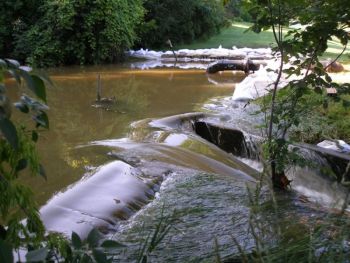Flood Hydrology: Difference between revisions
No edit summary |
No edit summary |
||
| Line 9: | Line 9: | ||
|style="text-align:center; font-size:90%;"| Extreme flood do occur. Learn more [https://damfailures.org/lessons-learned/extreme-floods-do-occur/ here] | |style="text-align:center; font-size:90%;"| Extreme flood do occur. Learn more [https://damfailures.org/lessons-learned/extreme-floods-do-occur/ here] | ||
|} | |} | ||
<!-- Delete any sections that are not necessary to your topic. Add pictures/sections as needed --> | |||
[[Hydrology]] is essential not only in the design of a dam, but also in the feasibility study of a dam and in assessments of the dam into the future as the state-of-the-practice evolves. The three main components of [[Flood Hydrology|flood hydrology]], according to the United States [[Bureau of Reclamation]] (USBR) are “(1) hydrometeorology related to probable maximum [[precipitation]] determinations, (2) probable maximum flood hydrograph determinations, and (3) statistics and probabilities relating to the magnitude and frequency of flood flows”.<ref name="FHM">[[Flood Hydrology Manual | Flood Hydrology Manual, USBR, 1989]]</ref> | |||
“One of the most common causes of dam failures is the inability to safely pass flood flows. Failures caused by hydrologic conditions can range from sudden failure, with complete breaching or collapse of the dam, to gradual failure, with progressive erosion and partial breaching”.<ref name="FEMA94">[[Selecting and Accommodating Inflow Design Floods for Dams (FEMA P-94) | FEMA P-94 Federal Guidelines for Dam Safety: Selecting and Accommodating Inflow Design Floods for Dams, FEMA, 2013]]</ref> Therefore, hydrologic studies are among the most important sources of information when it comes to dam safety. | |||
==Methodologies== | ==Methodologies== | ||
Revision as of 00:34, 13 December 2022
[Paragraph here]

|
| Extreme flood do occur. Learn more here |
Hydrology is essential not only in the design of a dam, but also in the feasibility study of a dam and in assessments of the dam into the future as the state-of-the-practice evolves. The three main components of flood hydrology, according to the United States Bureau of Reclamation (USBR) are “(1) hydrometeorology related to probable maximum precipitation determinations, (2) probable maximum flood hydrograph determinations, and (3) statistics and probabilities relating to the magnitude and frequency of flood flows”.[1]
“One of the most common causes of dam failures is the inability to safely pass flood flows. Failures caused by hydrologic conditions can range from sudden failure, with complete breaching or collapse of the dam, to gradual failure, with progressive erosion and partial breaching”.[2] Therefore, hydrologic studies are among the most important sources of information when it comes to dam safety.
Methodologies
Examples
![]() Learn more about the occurrence of extreme floods at DamFailures.org
Learn more about the occurrence of extreme floods at DamFailures.org
Best Practices Resources
![]() Hydrologic Engineering Requirements for Reservoirs (EM 1110-2-1420) (U.S. Army Corps of Engineers)
Hydrologic Engineering Requirements for Reservoirs (EM 1110-2-1420) (U.S. Army Corps of Engineers)
![]() Technical Release 210-60: Earth Dams and Reservoirs (Natural Resources Conservation Service)
Technical Release 210-60: Earth Dams and Reservoirs (Natural Resources Conservation Service)
![]() Flood Hydrology Manual (Bureau of Reclamation)
Flood Hydrology Manual (Bureau of Reclamation)
Trainings
![]() Dam Owner Academy: Extreme Rainfall Events
Dam Owner Academy: Extreme Rainfall Events
Citations:
Revision ID: 5213
Revision Date: 12/13/2022
